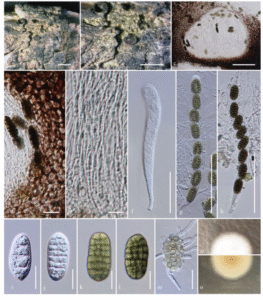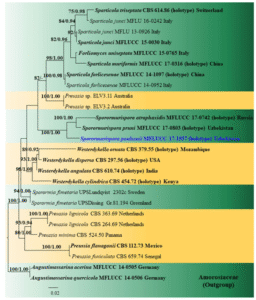Sporormurispora paulsenii D.Pem, Gafforov & K.D. Hyde, sp. nov.
Index Fungorum number: IF 556258; MycoBank number: MB 550831; Facesoffungi number: FoF 06252; Fig. 25
Etymology: The epithet reflects the name of the host plant 'paulsenii'
Holotype: TASM 6149.
Saprobic in terrestrial habitats. Sexual morph: Ascomata 673–757 μm × 470–589 μm (x̅ = 715.5 × 529.6 μm, n = 10), black, immersed to erumpent, solitary or in groups, gregarious or confluent, disc-shaped, uniloculate, without an ostiole. Peridium 43–52 μm thick, comprising 2 layers, outer layer comprising heavily pigmented, thick-walled, dark brown amorphous layer, middle layer comprising thick-walled, blackish to dark brown loosely packed cells of textura angularis, inner layer composed hyaline, flattened, thick-walled cells of textura angularis. Hamathecium 1.5–2.0 μm (n = 20), comprising numerous, filamentous, branched, septate pseudoparaphyses. Asci 129–283 × 18–22 μm (x̅ = 180.4 × 18.9 μm, n = 10), 8-spored, bitunicate, fissitunicate, cylindrical, short-pedicellate, apex rounded with a minute ocular chamber. Ascospores 32–35 × 16–19 μm (x̅ = 33.9 × 18.2 μm, n = 10), uniseriate to overlapping uniseriate, muriform, mostly ellipsoid, 7–10-transversely septate, with 2–3-longitudinal septa, slightly constricted at the middle septum, initially hyaline, becoming dark brown at maturity, rounded at the ends. Asexual morph: Undetermined.
Culture characteristics: Colonies on MEA, 10–15 mm diam after 7 days at 16 ºC, margin regular, slightly raised, smooth surface, entire edge, cottony or woolly, whitish, well-defined edges with no pigmentation of the agar.
Material examined: UZBEKISTAN, Surxondaryo, Province, Boysun district, Omonxona village, South-Western Hissar Mountains, on branches of Colutea paulsenii (Fabaceae), 18 May 2016, Y. Gafforov, YG-S121-1 (TASM 6149, holotype); MFLU 17-0112, isotype, ex-type living culture, MFLUCC 17-1957.
GenBank numbers: LSU: MK966143; SSU: MK963075; RPB2: MN023029.
Notes: Sporormurispora paulsenii was collected from Colutea paulsenii in Uzbekistan, and clusters with S. pruni (MFLUCC 17-0803) and S. atraphaxidis (MFLUCC 17-0742) with strong bootstrap support (100% ML and 1.00 PP) (Fig. 26). These taxa are similar in having a thick peridium, pseudoparaphyses, cylindrical asci and uniseriate, mostly ellipsoid, brown, muriform ascospores. However, S. paulsenii differs from S. atraphaxidis, the type species of Sporormurispora, in having disc- shaped ascomata, a thicker peridium (43–52 μm vs 15–25 μm), narrower hamathecium (1.5–2.0 μm vs 1.5–3 μm) and lacks an ostiole. Therefore, we introduce S. paulsenii as a new species.

Fig. 25 Sporormurispora paulsenii (TASM 6149, holotype). a,b Ascomata on host substrate. c Section of ascoma. d Peridium. e Pseudoparaphyses. f–h Asci. i–l Ascospores. m Germinating ascospores n,o Culture characteristics on MEA (n: Above view; o: Reverse view). Scale bars: a = 1000 μm, b = 1000 μm, c = 100 μm, d = 20 μm, e = 10 μm, f = 50 μm, g,h = 100 μm, i–l = 10 μm, m = 20 μm

Fig. 26 Phylogram generated from maximum likelihood analysis based on combined LSU, SSU and RPB2 sequence data retrieved from the GenBank. ML bootstrap values ≥ 50% are given as the first set of numbers and approximate likelihood-ratio test (aLRT) ≥ 0.90 values as the second set of numbers above the nodes. Voucher/strain numbers are given after the taxon names, the ones from type material are indicated in bold face. Newly generated sequence is indicated in blue. The bar length indicates the number of nucleotide substitutions per site
